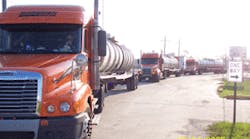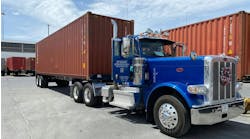Despite major disruptions caused by the flooding, widespread wind damage and general chaos that followed Katrina, truck fleets not only rushed to shoulder the heavy loads for early relief efforts, but also managed to be among the first private businesses to get back into business.
One day after the storm passed through Louisiana and Mississippi, for example, Schneider National had six drivers and three tractors moving diesel fuel from a U.S. Navy tanker docked in New Orleans to emergency generators for hospitals and to refueling locations for U.S. Army trucks.
Working under the directions of the Federal Emergency Management Administration (FEMA), the truckload carrier quickly doubled its diesel delivery fleet as rescue efforts picked up speed, said Todd Jadin, vp operations for Schneider National.
The Schneider tractors are offloading the fuel at 12 locations, creating what George Grossardt, vp & gm of Schneider Bulk Carriers, calls a “Rubik’s cube” network of drop locations. “Every drop location is different,” said Grossardt. “The tanks are different and the offloading mechanisms are different. Drivers need to be savvy in terms of knowing what facilities need what so that they can offload the fuel.”
Even though the carrier had four terminals affected by the storm, it also resumed freight shipments into the area within a week. A combination of relief aid and business shipments, "well over 100 loads" had been delivered by Wednesday, according to Jadin. "The business is back up and running," he told FleetOwner. "It's not easy. The routes open to get in there change every day, but drivers are relaying changes to us, and we're staying up on which routes are open."
Recognizing that many evacuate area residents have lost jobs as well as homes, Schneider National has also begun working with government job agencies in the area. "We have truck-driving jobs and training available, so we'll begin offering employment assistance," said Jadin.
With roots deep in Louisiana, regional LTL carrier Saia lost the use of an 80-door terminal in New Orleans and a smaller facility in Gulfport. "We had 7-ft. of water in the yard at Gulfport and lost 10 tractors," said Rick O'Dell, president and CEO. "Our New Orleans terminal stayed dry, but it lost part of the roof, which will have to be replaced."
A 35-door facility in Baton Rouge was quickly expanded with flatbeds pressed into dock use to handle much of the New Orleans freight, with another portion moved to Saia's Houma, LA, facility. Coverage for the Gulfport area was shifted to Hattiesburg, MS.
Although the Jefferson Parish location of its New Orleans terminal was closed to all under martial law, Saia was given permission to recover its equipment after it volunteered to make emergency deliveries for FEMA during the initial rescue efforts. "We took a busload of drivers in on Labor Day weekend, and got out all 50 tractors and the freight," said O'Dell.
"Our sales people are back and they're talking to customers who are getting back into operation and who want transportation services," O'Dell reported. While, traffic congestion in Baton Rouge and intermittent power outages are creating difficulties, "the areas surrounding New Orleans are coming back up much more quickly than I would have thought possible," O'Dell said.
Saia plans to reopen its New Orleans terminal next week once the roof had been replaced. While its Gulfport terminal escaped with just water damage, reopening there would have to wait until reliable power and communications services are restored, O'Dell said.
To discuss the Katrina disaster and its effect on the trucking industry or to share your personal experiences, please visit FleetOwner's Katrina Blog at blog.fleetowner.com/katrina.
To view the archive of FleetOwner’s ongoing Katrina news coverage, go to www.fleetowner.com/katrina.



